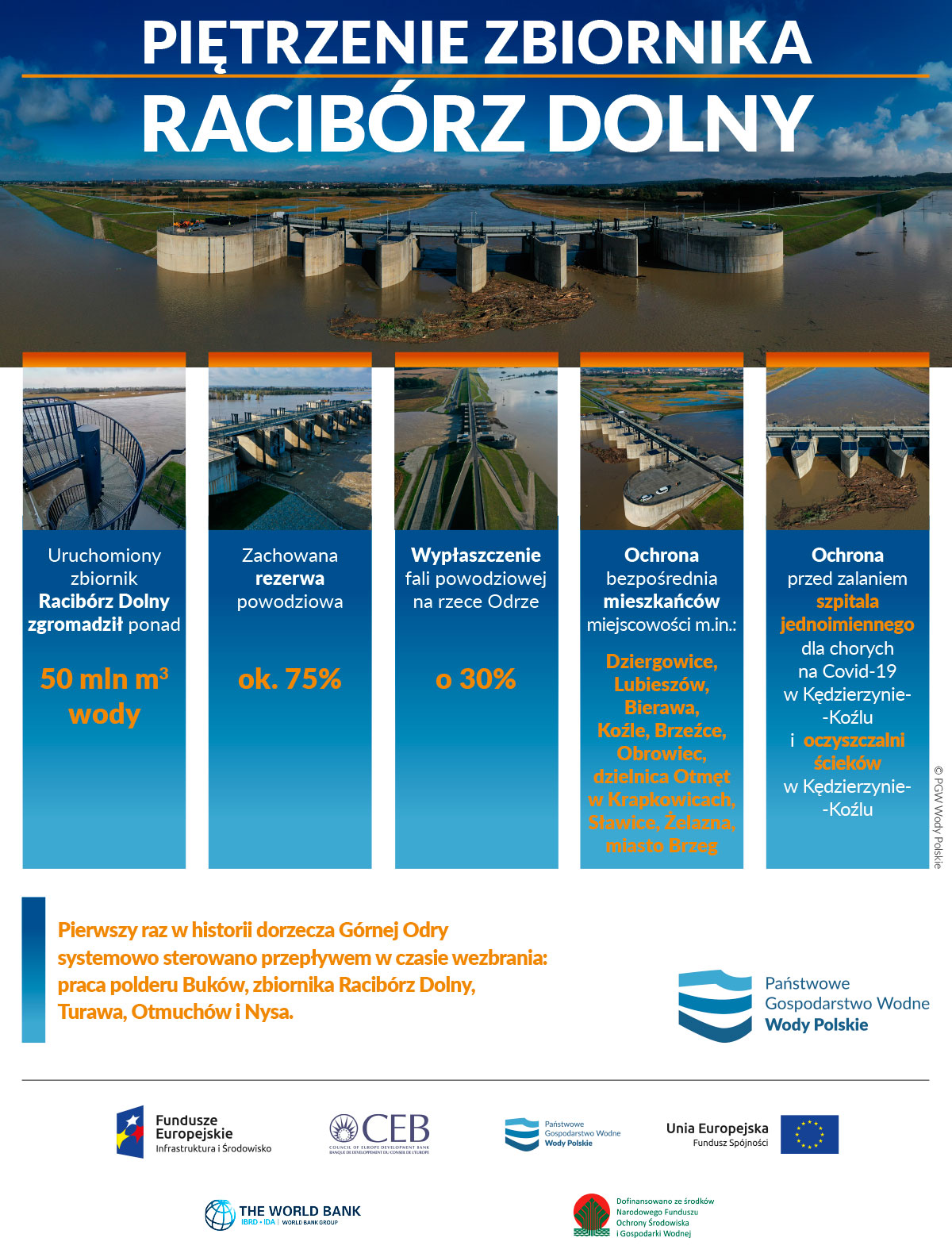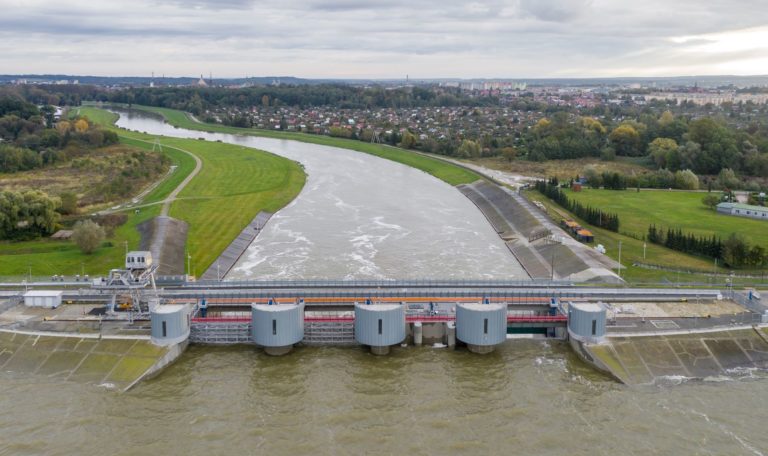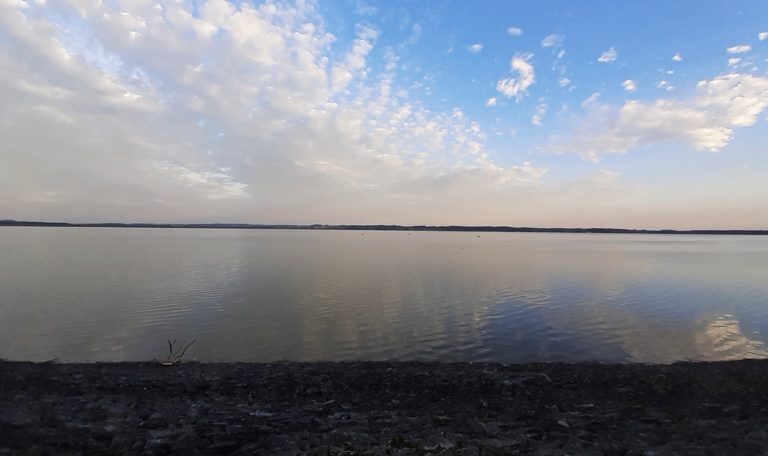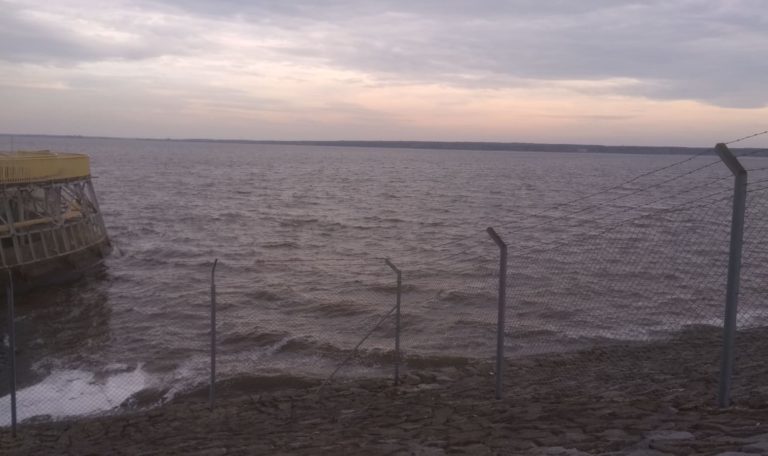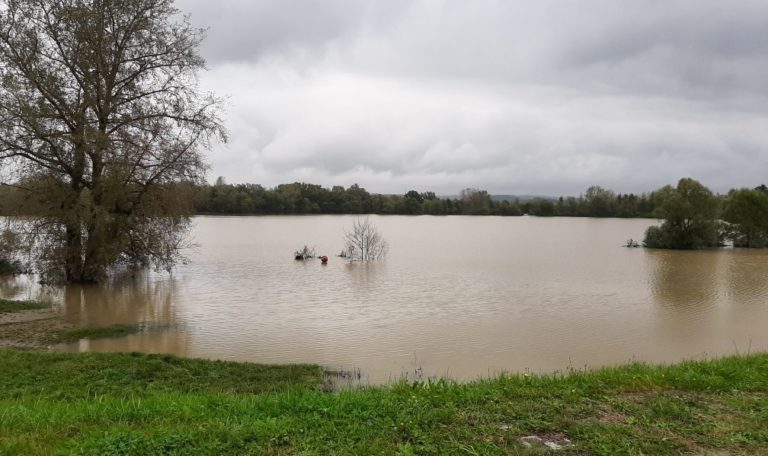The Odra river flowing through the Lower Racibórz Reservoir has returned to its original bed. However, over the past week, the canopy of the largest dry reservoir in the country intercepted the excess of water from the Odra, which protected the areas below – Racibórz through Opole to Wrocław – from the risk of flooding. Today no one has any doubts the decision to launch this facility was right.
Consistency in the operation of Polish Waters led to the completion of this key investment to increase the flood protection of the areas below the reservoir. The reduction of the flood height thanks to the flood protection reservoirs in the southern part of the country in recent days has shown the effectiveness of the Polish Water National Water Management. Thanks to the close coordination of the Racibórz, Turawa, Otmuchów and Nysa flood protection reservoirs, it was possible to reduce the flood risk from the Odra river in the provinces, Silesia, Opole and Lower Silesia. Currently, the Odra river within the Racibórz polder is in the channel regime. Backwaters in the area of the dry reservoir result from the object’s topography. They will be gradually absorbed, evaporated and will flow safely to the river bed.
Racibórz Reservoir
The construction of a dry reservoir in Racibórz was completed at the turn of May and June this year. It covers an area of 26 km2, and has a designed capacity of 185 million cubic meters. The cost of the investment, co-financed by the European Union, World Bank, Council of Europe Development Bank and the state budget amounted to approx. PLN 2 billion. The damming of water in the Racibórz Dolny reservoir began on October 14, at approx. 15:30. Przemysław Daca, the President of the State Water Management Authority of Poland, made this decision at the request of the Voivode of Opole. The upcoming flood wave and hydrological forecasts predicted the risk of flooding not only for the residential buildings and infrastructure of the saved “island” in Brzeg, but most of all for the unified hospital in Kędzierzyn-Koźle, a strategic unit where patients with covid-19 are treated.
By 09:00 on October 19, 2020, the reservoir in Racibórz retained about 45 million cubic meters of water, with a flood reserve of 140 million cubic meters. The polder was filled in about 27% (50.5 million m3) of its capacity. Water storage effectively reduced the flood wave. At the point of culmination, the reduction was around 30%. The tank started emptying automatically on October 19 this year – the inflow to the tank was lower than the outflow. The Racibórz reservoir also cooperated with the Buków polder located above, with a flood capacity of 57 million cubic meters. At maximum point – polder received approx. 17 million cubic meters, i.e. 31% of its capacity.
Empty reservoir in Racibórz (photo: Polish Waters)
Flood wave
The Racibórz-Miedonia water gauge post in the Górna Oda catchment area on October 14 this year at 16:00 showed an ordinate of approx. 715 cm with a flow of approx. 767 cubic meters/ s. The flood wave was cut by the Racibórz Dolny reservoir and the Buków Polder. The maximum inflow to the Racibórz Dolny reservoir was 868 cubic meters/s. The culmination of the flood wave began to leave the area of RWMA in Gliwice (water gauge Ujście Nysy Kłodzkiej) in the morning hours of October 17, 2020.
Parallel to the development of the situation on the Odra River, the Flood Protection Operational Centers in Gliwice and Wrocław have developed an optimal solution to avoid overlapping flood waves due to the operation of the Turawa, Otmuchów and Nysa reservoirs. At that time, the cascade reservoirs of Nysa had used almost the entire available flood reserve, which necessitated water discharge. The decision to increase the runoff from the reservoirs at the right time also to determine their flows, and above all to launch Buków and Racibórz Dolny polders, resulted in protecting many towns from flooding within 6 days (from October 14, 2020 to October 19, 2020). Among them were: Dziergowice, Lubieszów, Bierawa, Koźle, Brzeźce, Obrowiec,, Sławice, Żelazna, and the city of Brzeg. Additionally, the flattening of the flood wave prevented flooding the sewage treatment plant in Kędzierzyn-Koźle. The operation of the Racibórz Dolny reservoir is a historic moment – for the first time, the largest hydrotechnical facility of this type in Poland allowed Polish Waters to systematically control the water in the Upper Odra River Basin, exerting an active influence on the catchment area.
The ordinates on some rivers in the Upper Odra region during the current flood (eg Osobłoga) were close to the value of 1% water – 100-year-old water. The highest level at the Racławice Śląskie water gauge was recorded on October 14, 2020 at 19:00 – 414 cm = 92 cubic meters/ s. For comparison – the water gauge profile of Racławice Śląskie on 07.07.1997 reached 438 cm. Rise similar to the present one took place previously in October 1936. If the Racibórz Dolny reservoir remained passive, the flood would cause significant material losses covering – among others – The Bierawa commune and the “Island” estate in Brzeg.
Currently, the water at the gauging stations in the Upper Odra catchment area is falling or stabilizing.
The prolonging flood wave has had an impact on the maintenance of the average and high water level exceeding the warning and alarm levels. The reservoirs in the Upper Odra catchment area administered by the Regional Water Management Board in Gliwice and Wrocław managed to reduce the peaks of flood waves of individual rivers. Currently, the flood reserve is being rebuilt by increasing the runoff. Monitoring of flood embankments is still being carried out, culverts are being secured and blockages caused by high water deposition of branches and other elements taken by the water are being removed.
Polish Waters would like to thank all the people and institutions involved in the protection against the flood wave. We would like to thank the voivodes and voivodship crisis management teams in Katowice, Opole and Wrocław, the local government authorities of Racibórz, Nysa, Brzeg and Oława, as well as firefighters from the VFB and SFB, soldiers of the Territorial Defense Forces and VWRT services. It is also worth emphasizing the close and exemplary cooperation with the IMWM-NRI.
